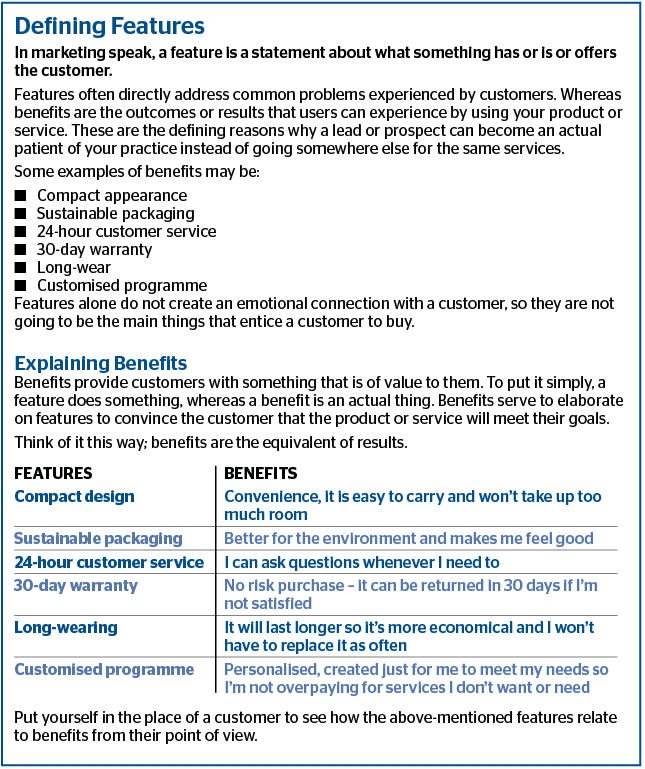Wendy Lewis explains why leading with your best features may not be a winning strategy
When it comes to defining a marketing strategy, there are two basic approaches you can take. The first focuses on what your products or services are and do, while the other focuses on how they can improve your customers’ lives.
Which approach do you want to go with? Clearly, the latter is more customer-centric, and therefore, more likely to be effective and achieve the growth you want.
Features versus benefits
It’s natural to strive to create a marketing strategy based on your brand’s best features. After all, they are the first thing that spring to mind when you are trying to stand out from the competition.
If you’re making a product, you must identify marketing tactics that focus on the product’s best features. The reasoning is understandable: features are the quantifiable things that your product does to create value for customers. Thus, product features are usually at the centre of a branding exercise.
Focusing on product features can make sense in some cases. However, for a high-end aesthetic practice, it may not be the ideal way to present your brand. Product features are useful to provide context; they help people understand what you do and what you offer and can guide them through make purchasing decisions. The downside is that promoting only the features of your offering does not always communicate a compelling enough story to encourage people to become actual clients or patients.
If the end goal of your marketing strategy is to increase product sales and generate repeat treatments, it seems reasonable to promote what you do in terms of services. However, you also need to clarify the characteristics that can benefit your customers so they can make informed purchasing decisions. Features don’t necessarily communicate benefits, which is why leading with product features may be a less effective strategy for medical aesthetics clinics.
Promoting product features may also make people feel like they are being sold to, which patients tend to resist. This strategy also forces the client to analyse all the features on their own to determine whether what you are selling is what they really want and consider whether they will benefit from it.
Marketing an aesthetic practice needs to attract people to want to find out more about who you are, what you do, and what your brand stands for. To sell more products and services, you must create a great experience for patients from the first point of contact, and that requires a strong integrated marketing strategy.
What’s in it for me?
Promoting benefits helps to answer the question that is foremost in consumers’ minds: ‘What’s in it for me?’
This type of content focuses on the advantages or the potential value clients can receive by becoming your patient or customer. It can inspire them to take the next step forward to making a purchase in your practice. Leading with benefits and presenting them as a solution to a patient pain point, such as wrinkles, muffin tops, thinning hair, sagging neck, is a better approach than presenting product features and expecting customers to piece together how these add up to the benefit that will solve their problem.
Applying this strategy to your practice
Get to know who your customers are by gathering information on each market segment you service. Analyse both demographic data (age, sex, household income, marital status, media preferences, lifestyle) and psychographic data (value system, primary hot button, mindset, response mechanisms, interests).
Put yourself in the position of your clients and patients. If you just function from your own point of view, you may tend to leap to assumptions that are not validated. While you may fully understand the nuances of the dermal fillers and laser treatments you offer, some patients may know very little about them or they may have learned what they know from various online outlets that may not be accurate or up to date. Don’t assume they can make the same connection about these devices and treatments that you can, or that they know why they will address their needs.
Try to approach your own products and services as if you have never heard of them before. Then, ask yourself what results each feature will deliver and why someone would consider buying it or having it done.
Think in terms of results
There’s nothing wrong with the term ‘benefits,’ but if you refocus to think in terms of ‘results,’ the situation becomes clearer. Your challenge is not really about features vs. benefits, but rather features vs. results. Look at the current features you promote and determine how to move each one into the results phase. Ask yourself what results can be achieved for each product and service offered in the practice. Then take it to the next level and consider how those results can impact your patients’ lives.
To create the most effective and nurturing experience in your practice, take the time to explain how the products and treatment you are recommending can deliver the benefits they are looking for. Place benefits before features to show your audience how their lives could change, then demonstrate the features that will help make that change.
Good product and service descriptions should include a healthy combination of both features and benefits to create a full picture for clients to make an informed decision. Highlight the most important features and describe how they work and what advantages they offer to address the client’s stated desires. This strategy will help ensure higher conversions with serious patients because the approach is thorough and will be perceived as more honest.
Consumers rarely want to buy things just for the sake of buying them. Rather, they will buy things to address their concerns and solve their problems. In real life, most consumers tend to care very little about all the time, efforts or R&D that went into developing a new feature. Most people only care about how it will impact themselves. Remember the ‘what’s in it for me?’ syndrome.
Feature-driven vs. benefit-driven marketing campaigns
Ads for electronics tend to be super aspirational. Think of Apple® as the quintessential example. The benefits of owning a cell phone, such as making calls, receiving calls, storing phone numbers, taking photos, etc., are not very sexy as we have come to expect those and much more.
Mobile devices tend to be sold on the quality, ingenuity, and reliability of the features they promote. The slimmer, sleeker, lighter, faster, longer battery life, sharper camera, and extra bells and whistles they have, the more we want them. This explains why so many of us change up our perfectly good phones and tablets in a year or two for the next model. For Apple®, it’s all about the features rather than the benefits that count with buyers and make us willing to pay over $1,200 USD for the newest iPhone X model.

Feature-based marketing can work well for certain types of businesses and product categories. However, for aesthetic practices, identifying and highlighting how your products and services can improve the lives of your clients and patients can be a more powerful strategy. This kind of messaging should be used across all channels, from the posts of your social media campaigns to the copy on your website, emails blasts, and seminar invitations.
By applying a results-oriented approach to uncover the true benefits your practice offers, you can be confident that the key marketing messages you use to reach your target audiences will be the right ones. This approach allows for an open dialogue and a chance for patients to get to know your brand, everyone in the practice, and have faith in what you can deliver for them.







